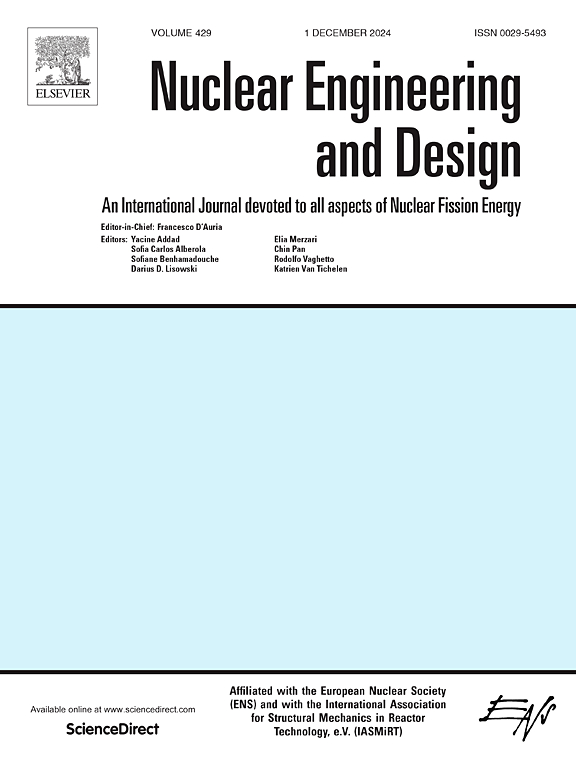Solidification of Cs-bearing melting fly ash by cement and metakaolin-based geopolymers
IF 2.1
3区 工程技术
Q1 NUCLEAR SCIENCE & TECHNOLOGY
引用次数: 0
Abstract
The melting fly ash (MFA) stored in the Interim Storage Facility in Fukushima, Japan, contains concentrated Cs, requiring stabilization for final disposal. This study investigates the physical properties to evaluate the feasibility of the MFA conditioning with B-type Portland blast furnace slag (BFS) cement and Na/K-activated metakaolin-based geopolymers (NaGP and KGP), with the evaluation of the Cs leaching behavior from solidified forms. Because of the difference in flowability, the volume of the solidified MFA waste can be remarkably reduced by a factor of 2.4 to 2.6 by selecting NaGP or KGP, respectively, compared to BFS cement. MFA incorporation into the cementitious materials reduced the uniaxial compressive strength (UCS), though the UCS values were large enough for the final disposal in Japan.
In ultra-pure water, the Cs cumulative leached fraction (CLF) is significantly lower for geopolymers, followed by BFS cement. Although model MFA contained KCl and NaCl, geopolymers showed better performance at Cs immobilization than BFS cement. In seawater leaching, CLF of Cs exhibits no significant differences among the matrices, likely due to an increase of Cs leaching in GPs by cation exchange. Matrix choice can influence the Cs leaching behavior of solidified MFA, especially in dilute leachate environments. The Cs immobilization ability of MFA solidified with BFS cement, NaGP, and KGP met the requirement set forth by the U.S. Nuclear Regulatory Commission.
水泥和偏高岭土聚合物固化含碳熔融粉煤灰
储存在日本福岛临时储存设施中的熔融飞灰(MFA)含有高浓度的碳,需要稳定化才能最终处理。本研究考察了b型硅酸盐高炉矿渣(BFS)水泥和Na/ k活化偏高岭土基地聚合物(NaGP和KGP)对MFA调质的可行性,并对固化形态的Cs浸出行为进行了评价。由于流动性的差异,与BFS水泥相比,选择NaGP或KGP可以显著减少固化MFA废物的体积,分别减少2.4至2.6倍。MFA掺入胶凝材料降低了单轴抗压强度(UCS),尽管UCS值足以在日本进行最终处理。在超纯水中,地聚合物的Cs累积浸出分数(CLF)明显较低,其次是BFS水泥。虽然模型MFA中含有KCl和NaCl,但地聚合物对Cs的固定性能优于BFS水泥。在海水浸出过程中,Cs的CLF在基质之间没有显著差异,这可能是由于阳离子交换增加了Cs在GPs中的浸出。基质的选择会影响固化MFA的Cs浸出行为,尤其是在稀渗环境下。BFS水泥、NaGP和KGP固化MFA的Cs固定能力符合美国核管理委员会的要求。
本文章由计算机程序翻译,如有差异,请以英文原文为准。
求助全文
约1分钟内获得全文
求助全文
来源期刊

Nuclear Engineering and Design
工程技术-核科学技术
CiteScore
3.40
自引率
11.80%
发文量
377
审稿时长
5 months
期刊介绍:
Nuclear Engineering and Design covers the wide range of disciplines involved in the engineering, design, safety and construction of nuclear fission reactors. The Editors welcome papers both on applied and innovative aspects and developments in nuclear science and technology.
Fundamentals of Reactor Design include:
• Thermal-Hydraulics and Core Physics
• Safety Analysis, Risk Assessment (PSA)
• Structural and Mechanical Engineering
• Materials Science
• Fuel Behavior and Design
• Structural Plant Design
• Engineering of Reactor Components
• Experiments
Aspects beyond fundamentals of Reactor Design covered:
• Accident Mitigation Measures
• Reactor Control Systems
• Licensing Issues
• Safeguard Engineering
• Economy of Plants
• Reprocessing / Waste Disposal
• Applications of Nuclear Energy
• Maintenance
• Decommissioning
Papers on new reactor ideas and developments (Generation IV reactors) such as inherently safe modular HTRs, High Performance LWRs/HWRs and LMFBs/GFR will be considered; Actinide Burners, Accelerator Driven Systems, Energy Amplifiers and other special designs of power and research reactors and their applications are also encouraged.
 求助内容:
求助内容: 应助结果提醒方式:
应助结果提醒方式:


